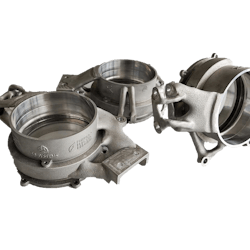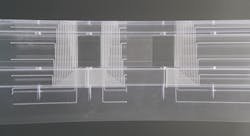Incremental performance improvements have a way of directly translating to wins within motorsports. How important can an incremental improvement be? Considering that a 5% decrease in drag can potentially increase horsepower by 25%, the answer is significant.
How successful a team realizes improvements starts with its ability to leverage innovation. To consistently achieve these results motorsports teams from a wide array of race circuits including Formula, Moto-GP and NASCAR are noticeably pivoting to additive manufacturing with a focus on accelerating innovation – enabling rapid iteration of part and system design to improve performance and lower cost.Why additive? Achieving such results often means designing and producing up to 600 parts per week. Accomplishing this with traditional manufacturing methods would require a manufacturing site the size of a small town, but race teams are able to sustainably accomplish the goal with additive.
“Hundreds of parts may not sound like a lot, but these teams are developing unique parts with multiple versions to support stringent testing requirements,” says 3D Systems’ Transportation & Motorsports Segment Leader Kevin Baughey. “They really push the envelope in terms of productivity if you consider what goes into each part from design to production.”
Evolutionary mindset
The key to success for motorsports teams has been the willingness to embrace a new mindset. “Early in the design process – whether it's for individual parts or entire systems – the ultimate manufacturing process is often front of mind for engineers,” says Baughey. “Realizing the real potential of additive only occurs when engineers embrace the mindset of including the entire array of manufacturing methods from the beginning."
This mindset has become ingrained within the motorsports arena. And as teams continue to expand their reliance on additive, the ongoing evolution of advanced materials is equally important. For instance, with on-track or on-road testing, it’s important to have materials with the right mechanical properties to handle the extremes in terms of temperature, chemical, corrosion resistance or UV exposure.
“Having the right rigidity in these controlled environments is crucial. And we're still advancing a lot of those techniques and doing things like integrating pressure tappings into the surface,” he says. “It's one thing to be able to quickly produce the surface, quickly produce iterations and test performance, but to be able to integrate the systems right into the part is a really interesting application spotlighting additive’s capability. It's essentially an integrated circuit board inside the surface without interfering with the overall aerodynamic performance.”
New metal materials are also unearthing exciting opportunities for under the hood or powertrain applications as well. “Integrated exhaust or systems for multiple flow channels without requiring multiple assemblies can save weight, time and space,” he says. “There are also structural components where additive can provide unique solutions combined with optimized topology or generative design. We are also looking at opportunities in inertia management. In high dynamic rotating systems with heavy motion, taking inertia out improved efficiency and durability.”Forging the way
Motorsports success with additive is also paving new pathways for other industries as the maturing technology gains broader acceptance.
“Consumer auto realized some time ago that the serial waterfall development process was too constraining. They were making early concept decisions in this cycle, locking themselves out of solutions later on in the development,” says Baughey. “However, adopting product development systems that keep parallel options open longer in the development cycle empowers manufacturers. And additive can be a meaningful enabler.”
Embracing the notion that additive helps a manufacturer keep multiple design options open longer in the development cycle could prove prevalent in industries where there's radical innovation such as healthcare, consumer automotive and aerospace, explains Baughey. “We are at a point where there is a lot of technological innovation, which translates to a lot of iteration and therefore a lot of design,” he says. “Additive provides an avenue for manufacturers to keep that window open as they develop the science and product through its life cycling.”
Motorsports teams are constantly iterating, changing, testing, evaluating and refining – resulting in constant learning opportunities. “With each new application they're either really advancing the science and we're learning to understand the fundamentals, or we're really trying to streamline and make the process as efficient and effective as possibly, so we can replicate those and bring the parts into production,” he says.







